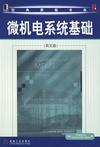微机电系统基础
出版时间:2008-1 出版社:机械工业 作者:刘昶 页数:530
Tag标签:无
内容概要
本书全面论述了微机电系统(MEMS)的基础知识,涵盖了MEMS技术的主要方面。同时引用了经典的MEMS研究论文和前沿的研究论文,为学生深入学习MEMS技术提供了指引。书中提炼出了四个典型的传感器实例:惯性传感器、压力传感器、流量传感器和触觉传感器,并介绍了利用不同原理、材料和工艺制造这些传感器的方法,既便于比较,又可以启发学生的创新意识并提高创新能力。 本书被美国伊利诺伊大学、斯坦福大学等选为教材。
作者简介
Chang Liu(刘昶)于1995年在美国加州理工学院获博士学位。1996年在美国伊利诺伊大学微电子实验室作博士后,1997年成为伊利诺伊大学电气与计算机工程系以及机械与工业工程系联合任命的助理教授,2003年获得终身职位并任副教授。
Chang Liu已经从事了14年MEMS领域的
书籍目录
PREFACEA NOTE TO INSTRUCTORSABOUT THE AUTHORNOTATIONAL CONVENTIONSChapter 1 Introduction 1.0 Preview 1.1 The History of MEMS Development 1.2 The Intrinsic Characteristics of MEMS 1.2.1 Miniaturization 1.2.2 Microelectronics Integration 1.2.3 Mass Fabrication with Precision 1.3 Devices: Sensors and Actuators 1.3.1 Energy Domains and Transducers 1.3.2 Sensors 1.3.3 Actuators Summary Problems ReferencesChapter 2 Introduction to Microfabrication 2.0 Preview 2.1 Overview of Microfabrication 2.2 The Microelectronics Fabrication Process 2.3 Silicon-Based MEMS Processes 2.4 New Materials and Fabrication Processes 2.5 Points of Consideration for Processing Summary Problems ReferencesChapter 3 Review of Essential Electrical and Mechanical Concepts 3.0 Preview 3.1 Conductivity of Semiconductors 3.1.1 Semiconductor Materials 3.1.2 Calculation of Charge Carrier Concentration 3.1.3 Conductivity and Resistivity 3.2 Crystal Planes and Orientation 3.3 Stress and Strain 3.3.1 Internal Force Analysis: Newton's Laws of Motion 3.3.2 Definitions of Stress and Strain 3.3.3 General Scalar Relation Between Tensile Stress and Strain 3.3.4 Mechanical Properties of Silicon and Related Thin Films 3.3.5 General Stress-Strain Relations 3.4 Flexural Beam Bending Analysis Under Simple Loading Conditions 3.4.1 Types of Beams 3.4.2 Longitudinal Strain Under Pure Bending 3.4.3 Deflection of Beams 3.4.4 Finding the Spring Constants 3.5 Torsional Deflections 3.6 Intrinsic Stress 3.7 Resonant Frequency and Quality Factor 3.8 Active Tuning of the Spring Constant and Resonant Frequency 3.9 A List of Suggested Courses and Books Summary Problems ReferencesChapter 4 Electrostatic Sensing and Actuation 4.0 Preview 103 4.1 Introduction to Electrostatic Sensors and Actuators 4.2 Parallel-Plate Capacitors 4.2.1 Capacitance of Parallel Plates 4.2.2 Equilibrium Position of Electrostatic Actuator Under Bias 4.2.3 Pull-In Effect of Parallel-Plate Actuators 4.3 Applications of Parallel-Plate Capacitors 4.3.1 Inertia Sensor 4.3.2 Pressure Sensor 4.3.3 Flow Sensor 4.3.4 Tactile Sensor 4.3.5 Parallel-Plate Actuators 4.4 Interdigitated Finger Capacitors 4.5 Applications of Comb-Drive Devices 4.5.1 Inertia Sensors 4.5.2 Actuators Summary Problems ReferencesChapter 5 Thermal Sensing and ActuationChapter 6 Piezoresistive SensorsChapter 7 Piexoelectric Sensing and ActuationChapter 8 Magnetic ActuationChapter 9 Summary of Sensing and ActuationChapter 10 Bulk Micromachining and Silicon Anisotropic EtchingChapter 11 Surface MicromachiningChapter 12 Polymer MEMSChapter 13 Microfluidics ApplicationsChapter 14 Instruments for Scanning Probe MicroscopyChapter 15 Optical MEMSChapter 16 MEMS Technology ManagementAppendix A Material PropertiesAppendix B Frequently Used Formulas for Beams and MembranesIndex
编辑推荐
《微机电系统基础(英文版)》被美国伊利诺伊大学、斯坦福大学等选为教材。《微机电系统基础(英文版)》特色:均衡了不同背景的学生(机械工程系学生和电子工程系学生)的需求。均衡地讨论了MEMS基础知识的三个支柱:设计、制造和材料。均衡地安排了理论基础和实践。
图书封面
图书标签Tags
无
评论、评分、阅读与下载
用户评论 (总计8条)
- 很不错的书,对微机电的总体有很大的帮助,而且对专业词汇也有很大的提高。
- 挺经典的书
- 对于初学者来说非常不错!
- thisbookcoversnearlyeverysubjectofMEMS,whichismuchusefulfornearhandtograspanoverlookofthisarea.Bytheway,re*****originalbooksyoucangetpretymorenewideas^
- 帮同学买的,说是这个领域里经典的书籍。
- 此书全面介绍了MEMS的基本知识,是一本很好的基础书,适合初学者!
- 没时间看,感觉还好
- 从第一章起,这本书就很实在。本书的目的是针对从事MEMS工作的本科生、研究生和工程技术人员而作。从各章的内容和后面的作业(任务)能看出,作者不仅仅在讲授知识,而且是实实在在地提出一个培养计划,在基础知识、调研能力、综述能力和设计能力各方面都对学生加以全面并深入的培训。很实在,典型的美国工科教材风格。
